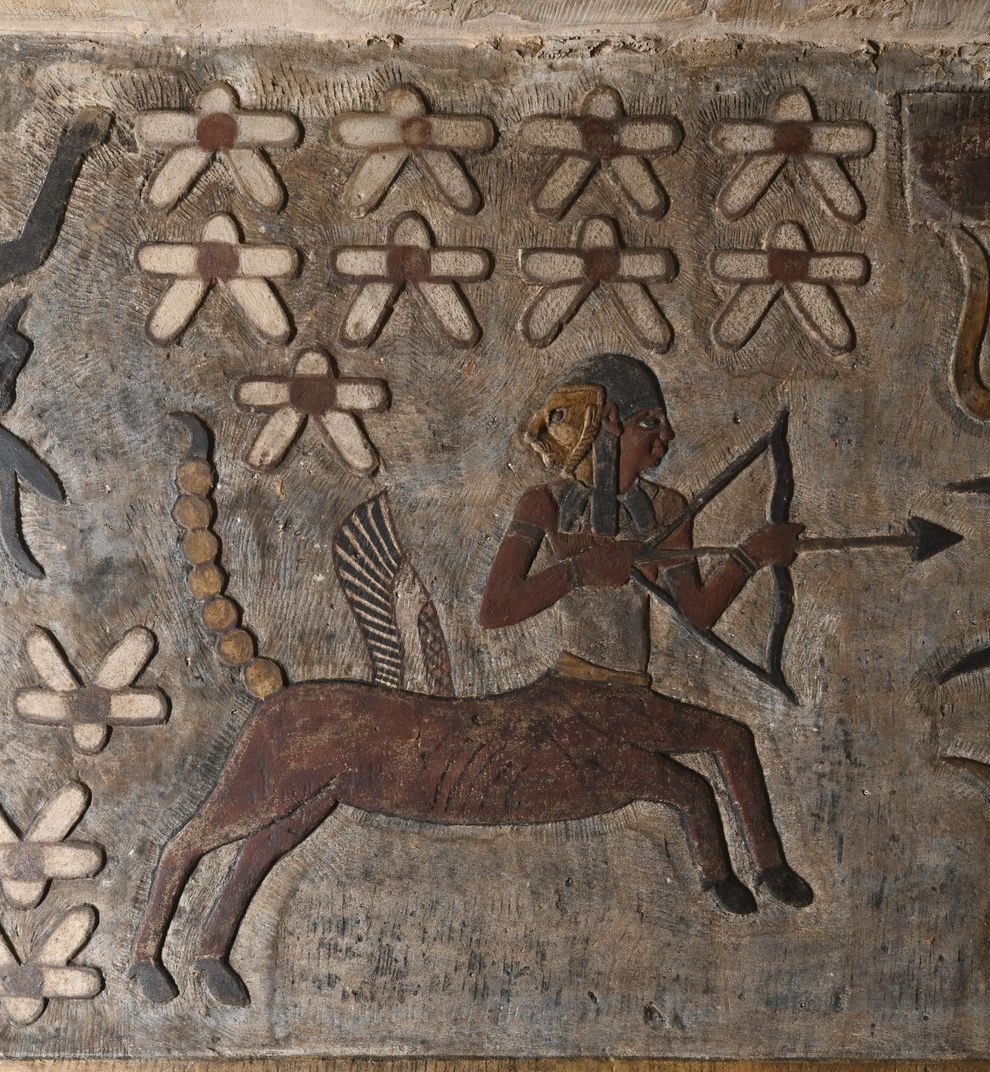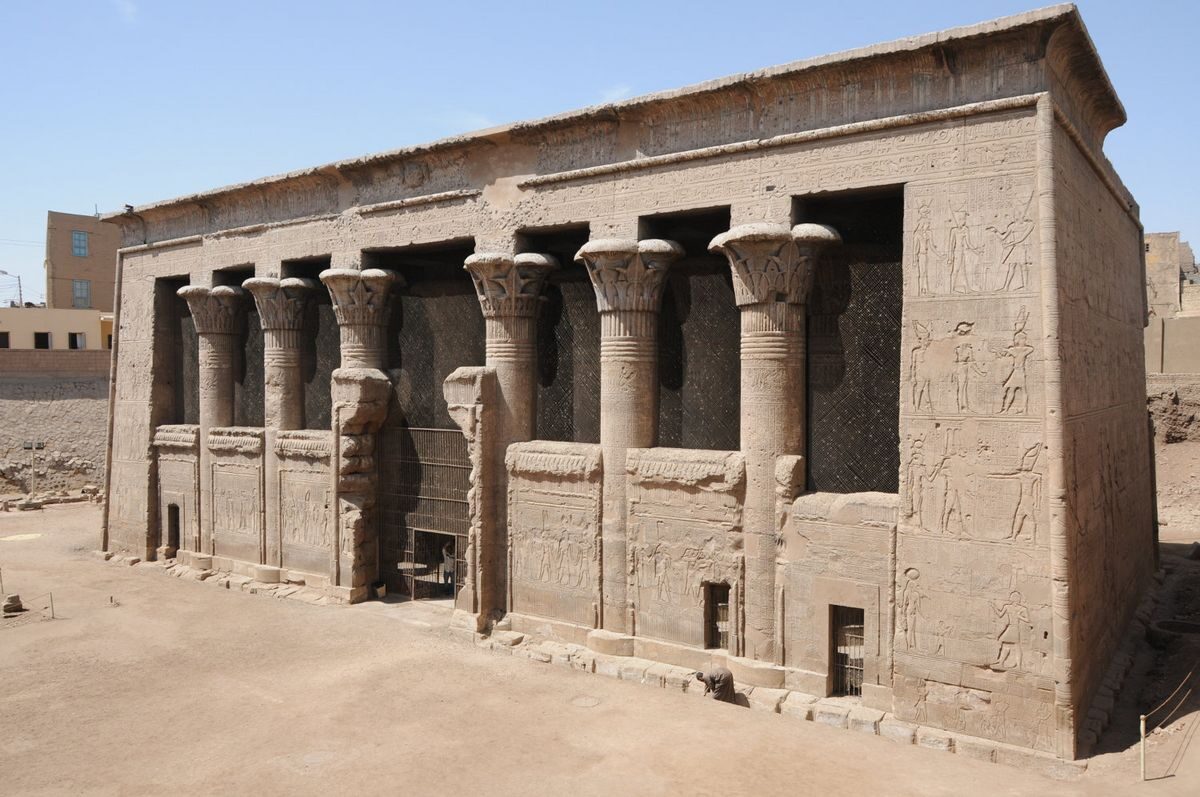
© University of TübingenRepresentation of the zodiac sign Sagittarius.
An Egyptian-German
research team has uncovered yet another series of colorful ceiling paintings at the Temple of Esna in Upper Egypt. The researchers reported that the Egyptian restoration team, led by Ahmed Emam, succeeded in completely restoring and re-coloring a representation of the heavens. The images, executed in relief, include a complete depiction of the
signs of the zodiac. Other reliefs show the planets Jupiter, Saturn and Mars, as well as a number of stars and constellations used in ancient times to measure time. The overall project is in the hands of Hisham El-Leithy of the Egyptian Ministry of Tourism and Antiquities and Professor Christian Leitz of the University of Tübingen.
"Representations of the zodiac are very rare in Egyptian temples," Leitz says, adding "The zodiac itself is part of Babylonian astronomy and does not appear in Egypt until Ptolemaic times." Researchers think the system of zodiac signs and their related constellations was introduced to Egypt by the Greeks and subsequently became popular. "The zodiac was used to decorate private tombs and sarcophagi and was of great importance in astrological texts, such as horoscopes found inscribed on pottery sherds," says Dr. Daniel von Recklinghausen, a Tübingen researcher. "However, it is rare in temple decoration: Apart from Esna, there are only two completely preserved versions left, both from Dendera," he says.

© University of TübingenTemple of Esna in Upper Egypt.

© University of TübingenRepresentation of the zodiac sign Sagittarius pre-restoration.
In addition to the zodiac and the star constellations, the restoration revealed colorful images of snakes, crocodiles and various fabulous beasts, including a snake with a ram's head and a bird with a crocodile's head, the tail of a snake and four wings. During the restoration, the researchers also discovered previously unknown inscriptions. In the temple of Esna, the colors had been covered by a layer of dirt and soot - and thus preserved - for nearly 2,000 years. However, the ceiling paintings and inscriptions were barely recognizable for centuries because they were so dirty.
The temple is in Esna, 60 kilometers south of Luxor in Egypt. Only the vestibule (called the pronaos) remains, but it is complete. At 37 meters long, 20 meters wide and 15 meters high, the sandstone structure was placed in front of the actual temple building under the Roman Emperor Claudius (41-54 AD) and probably eclipsed it. Its location in the middle of the city center probably contributed to the fact that the vestibule was preserved and was not used as a quarry for building materials as other ancient edifices were during the industrialization of Egypt. Even in Napoleon's time, the pronaos attracted attention among scholars, as it was considered an ideal example of ancient Egyptian temple architecture. The restoration work has been ongoing for five years, sponsored by the American Research Center in Egypt, the Ancient Egypt Foundation and the Gerda Henkel Foundation.
Esna project website



Reader Comments
So, what does seeing X-wing fighters say ...
I may came back in times of trouble ...
Ummm Dendera temple which predates the greeks turn in egypt by at least 1200yrs.
So it begs the question from me, Is the interpretation of the pre restoration image, just something in the eyes of the beholder?
It had not been born until the events of Exodus
If so, that would be appreciated Agent Mulder Did you know that saturn has rings?
It has many names, sumarian tiamat, babalon maldek, greek phaeton. That all three( venus, mars, earth) orbited this planet. Earth with an geosynchronous orbit.
Something caused the destruction of this planet. Mythologies tell of saturn being "relocated" in the sky.
The rings were not part of the planet yet
Or so the theories say
Ken
Sorry if that seems goofy.
But, I suspect the picture is incomplete, doesn't capture the full perspective, so it becomes speculation when you only have a snapshot image potentially of just a part of the whole scene.
~
Still, I find the image impressive and I wouldn't want to be the one the arrow is pointed towards.
BK
Best to you Hans,
Ken
As for dragonflies, I've seen them, but I prefer damselflies with their double-wings.
Now, I will share something between you and I, but I think my daughter has a little chick she hatched that is actually a whole new chicken species - it was the mixture of a silkie rooster with a bigger egg-laying bird, and I told my daughter, she know, just how proud I am of her.
~
Edit - well I have just learned that my 2-wing theory about damselflies was incorrect - but I know I've seen some flies with two sets of wings....so the moral of the story - live and learn I reckon.